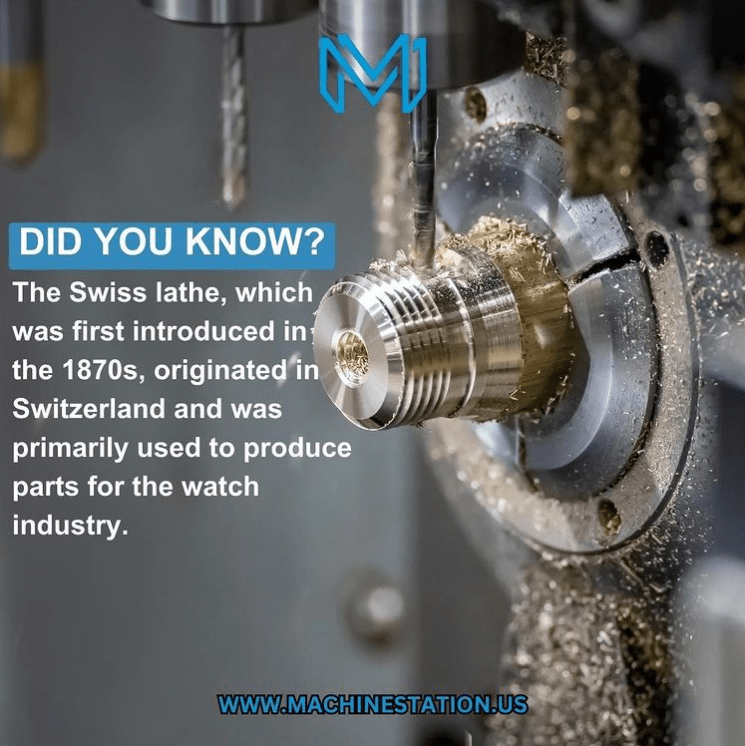During the 1800s, the Swiss introduced a new method for producing intricate, lengthy, and small watch parts. Since the Swiss highly valued the watch industry, they invented the Swiss Lathe to manufacture tiny components that traditional “fixed headstock lathes” could not create. The Swiss Lathe was crucial because the watch parts had an extreme length-to-diameter ratio and small diameters, which demanded the use of specialized tooling and delicate turning techniques.
Does the Swiss Type Lathe have a Headstock?
Conventional lathes using the fixed headstock principle face deflection issues under tool pressure when the length-to-diameter ratio exceeds 4:1. Typically, the workpiece is extended to the desired length before being turned to the required diameter, and this was the standard limit. However, the size of the stock, length, and diameter to be turned, along with the number of passes required to attain the final diameter, could permit exceeding the 4:1 ratio in specific situations. Tailstocks and steady rests can assist in turning longer lengths, but they are only practical for larger parts. Swiss machines, on the other hand, are typically used for diameters up to 38mm, with the most significant application for bar sizes under 1″.

How does a Swiss Type Lathe use a bar feeder?
CNC Swiss Type Lathes are purpose-built for running bar stock and frequently use 12-foot-long bars. These machines can also have automatic magazine bar feeders capable of stacking multiple bars and reloading them automatically once a bar is depleted, making them ideal for high-volume production.
It is exceptionally rare to use a Swiss type lathe for secondary operation work, where a turned part is reclamped in the primary spindle for further processing.
The Swiss turning machine’s exceptional efficiency in turning long, slender parts from a bar is due to its utilization of a guide bushing. The guide bushing is located in the headstock casting, and its inner diameter is accurately sized within tenths to match the bar’s diameter. A collet, placed in the sliding headstock behind the guide bushing, holds the bar in place. The bar is then pushed through the guide bushing (Z-Axis), while the turning tools, positioned just in front of the guide bushing, move to a specified diameter (X-Axis). This process ensures the turning process is carried out with virtually no deflection of the workpiece, resulting in precise and accurate parts.
How does the bar affect processes?
The precision required in the centerless grinding process was of utmost importance as any deviation in the bar’s diameter could cause it to bind in the guide bushing, resulting in a broken tool, wasted material, and prolonged downtime. Moreover, due to the non-rotating guide bushing, there was limited support for the bar, which made it essential to keep the bar’s diameter as consistent as possible to prevent it from flexing and causing vibrations during machining, leading to inferior surface finishes and dimensional accuracy. As a result, Swiss automatics required skilled operators who could monitor and adjust the cutting parameters constantly to achieve the desired results. Despite these challenges, the Swiss automatics of that era were considered groundbreaking for their high productivity, accuracy, and versatility, paving the way for modern CNC machines.
What are the change from the original cam driven Swiss Type Lathe?
Nowadays, almost all manufacturers of Swiss-style turning machines integrate a driven, synchronous guide bushing that rotates 1:1 with the headstock collet, substantially decreasing the risk of friction and heat. However, despite this improvement, most Swiss machine manufacturers still prefer using cutting oil instead of water-soluble cutting fluid.
This is because cutting oil is better at lubricating the machine and preventing rust and premature wear. Employing water-based coolant may cause used Swiss machines to lose much of their value, making them difficult to sell when potential buyers discover this fact.
Modern CNC Swiss Automatic machines have undergone significant advancements from the original cam-driven Swiss turning machine. Currently, nearly all Swiss machines incorporate two spindles – main and sub, both equipped with an independent “C” Axis, live tooling, and a “Y” Axis that enables a live tool to move above and below the centerline. Additionally, several manufacturers provide a “B” or rotational axis for a tool bank capable of executing complete features on a part.

What should you expect from your Swiss Type Lathe?
Moreover, in addition to these advanced features, some manufacturers offer hybrid models that provide fully-loaded machines capable of operating with or without a guide bushing. This feature is particularly useful when running a brief series of parts, making it more efficient to run without the guide bushing. To function without the guide bushing, the bushing holder is detached, allowing the headstock collet to extend into the headstock casting, enabling the machine to operate like a fixed headstock lathe with a linear Z-Axis. As a result, the stock can be regular mill-run material with some fluctuations in the outer diameter.
Used Swiss machines typically remain in excellent running condition even after 8-10 years of high-production use. The utilization of cutting oil significantly prolongs the mechanical components’ life, such as the linear guide rails found on most Swiss lathes. Additionally, the small and intricate parts do not burden the machine as much as they would on an 8″ or 10″ chuck lathe.
Star, Citizen, and Tsugami are the most sought-after Swiss machine brands, while Tornos, Hanwha, and Nexturn account for a smaller portion of the market. Generally, it is uncommon to find a top-quality brand that is 4 or 5 years old since individuals typically hold onto well-equipped Swiss machines until they see significant changes in technology before considering selling the machine.



